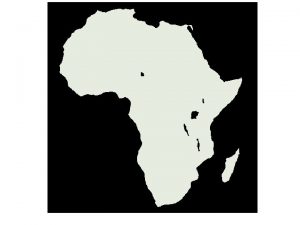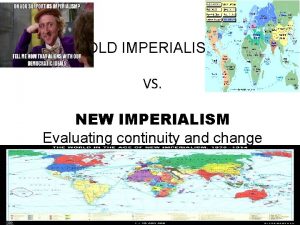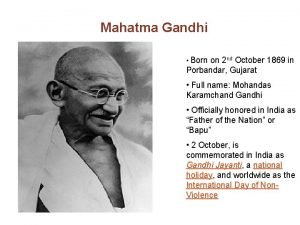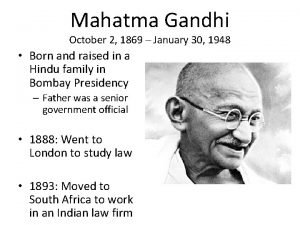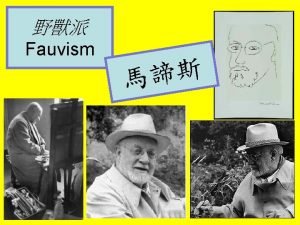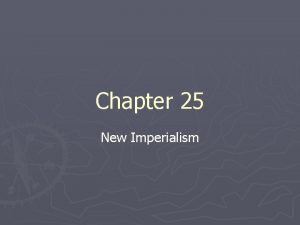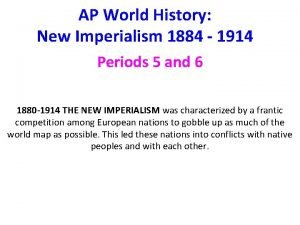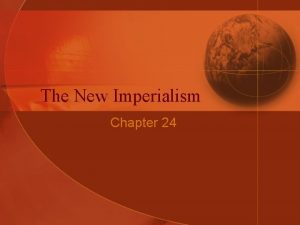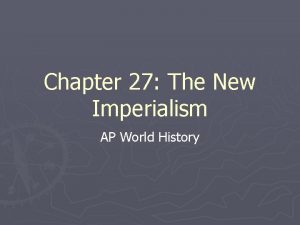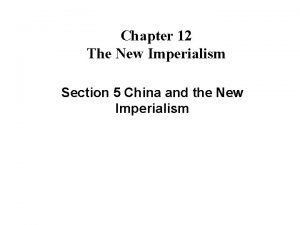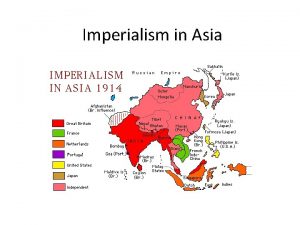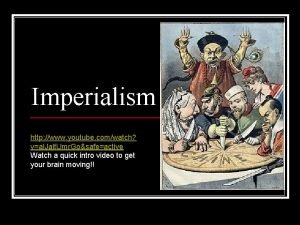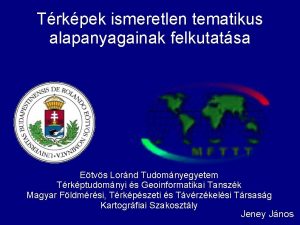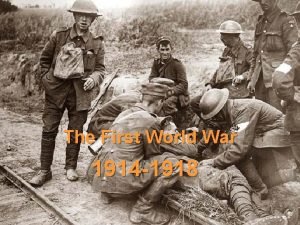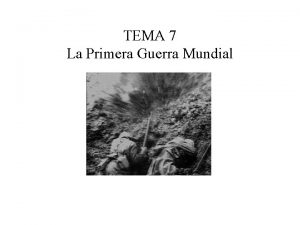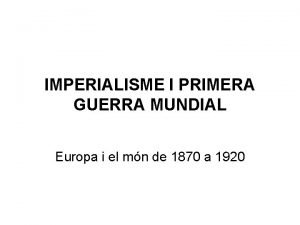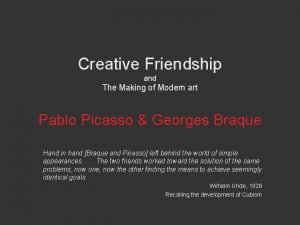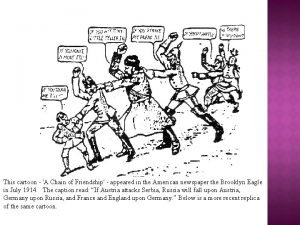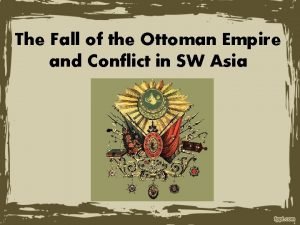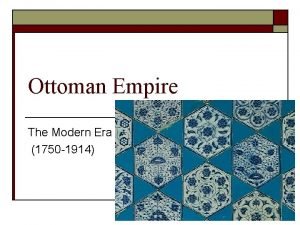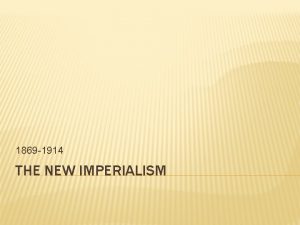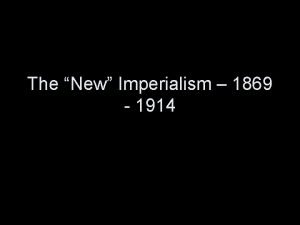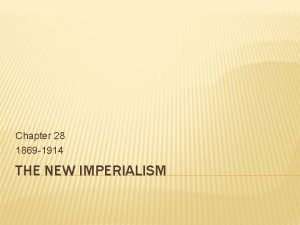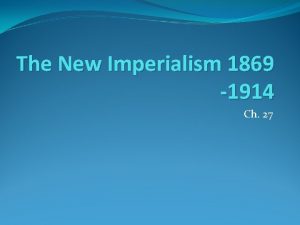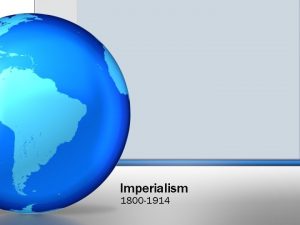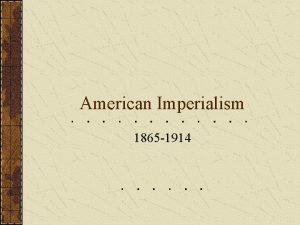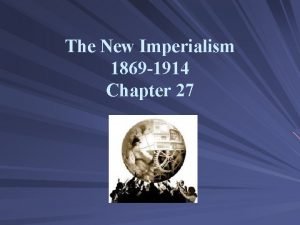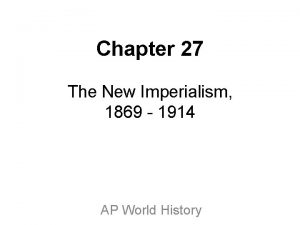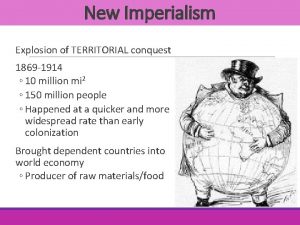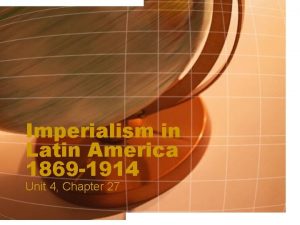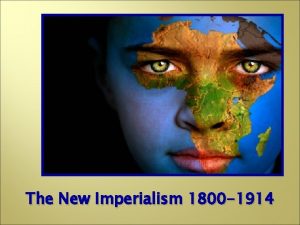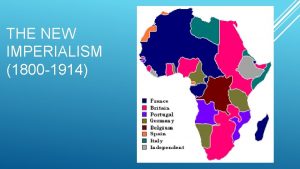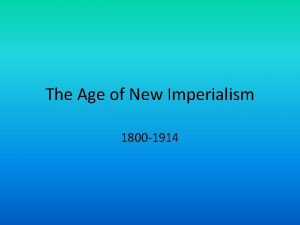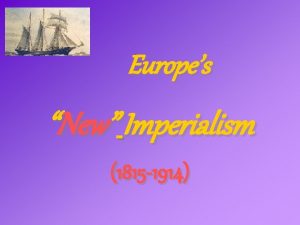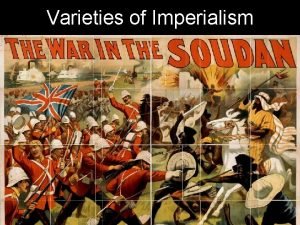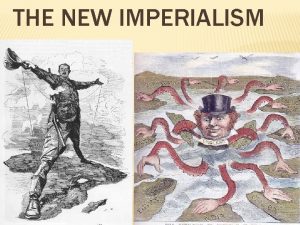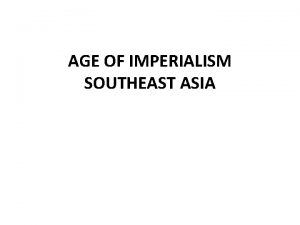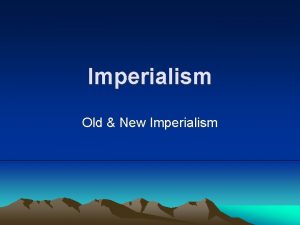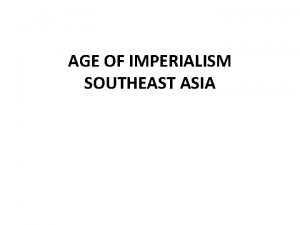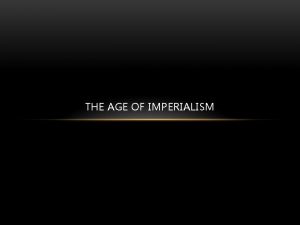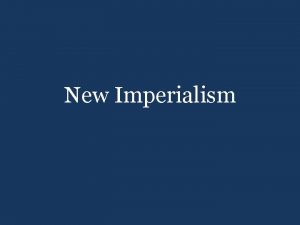I The New Imperialism 1869 1914 A Methods








































- Slides: 40

I. The New Imperialism (1869– 1914)

A. Methods & Motives 1. “New Imperialism”: explosion of territorial conquest in Africa, Asia, & Latin America – suppliers of agricultural products/raw materials, consumers of industrial products 2. competition & nationalism 3. exporting Western “civilization” 4. Social Darwinism: “The White Man’s Burden”

B. Governmental Support 1. Entrepreneurs & investors looked to profit from mines, plantations, & railroads – minerals – industrial crops – stimulants: sugar, coffee, tea, & tobacco 2. Governments provided diplomatic & military support

C. Imperial Tech Inventions: - the breechloader smokeless powder machine gun Suez Canal quinine (anti-malaria)

Suez Canal

D. Colonialism 1. colonialism: system of administering & exploiting colonies for the home country 2. SPHERE OF INFLUENCE: country has exclusive rights to trade in particular region

II. The Scramble for Africa

A. Egypt: 1. Egyptian khedives carried out expensive modernization projects (loans from British/French) 2. 1882: British sent army into Egypt (70 yr. indirect rule) 3. British built Aswan Dam on Nile (cotton)

B. West & Equatorial Africa 1. W. Africa: French built railroad from Senegal to Niger 2. Congo Basin: King Leopold II of Belgium claimed south of the Congo River (Henry Stanley explorer)… rubber trees

Congolese Rubber Tapping

A man who refused to go work in the rubber plantation looks at the severed foot and hand of his 5 year old daughter.

C. South Africa 1. Good farmland & mineral wealth - discovery of diamonds at Kimberley (1868) - British Cape Colony expands - British South Africa Co. (owner Cecil Rhodes) takes over land in c. Africa (Rhodesia) 2. Union of South Africa formed (1910) - Afrikaners ruled & instituted apartheid (segregation)

D. Dividing Africa 1. Bismarck called the Berlin Conference on Africa (1885 -86) – discussed how to carve up Africa by Europe

Responding to Colonialism • Africa at the time of the European invasion contained a variety of societies. • These societies responded differently to the European invasion; some welcomed the Europeans as allies against local enemies, while others resisted European rule.

Fighting Back • Pastoral and warrior states like the Zulu and the Ndebele resisted European invasion. • So did some commercial states like the kingdom of Asante and Benin. • Ethiopia successfully defended itself against an Italian invasion in 1896.

Life Changes • In the face of European invasion most Africans simply tried to continue living as before, but colonial policies made this difficult. • Colonial emphasis on the following was very disruptive: – production of cash crops – assignment of land to European companies and planters – hut taxes or head taxes • The need to pay taxes in cash forced African men to take low-paid jobs and to migrate to the cities and mining camps in search of work.

Women and Colonialism • Some African women welcomed colonial rule because it put an end to fighting and slave trading, but most women benefited less than men did. • Women’s property rights were undermined by colonial policies that assigned property rights to the head of the household – the man.

Christianity and Colonialism • Missionaries were the main conduits by which Africans came into contact with European culture. • Missionaries taught both practical skills (crafts and domestic skills) and western ideas. • Africans educated in mission schools found that Christian ideals clashed with the reality of colonial exploitation; they began using Christian ideas to critique colonialism.

Islam and Colonialism • Islam continued to spread southward during the colonial period. Colonialism contributed to the diffusion of Islam by building cities, increasing trade, and allowing Muslims to settle in new areas.

Asia and Western Dominance

Central Asia • Between 1865 and 1876 Russia was able to use modern weapons to advance into Central Asia. • The nomadic Kazhaks resisted fiercely, but by the end of the nineteenth century they were reduced to starvation, their grazing lands fenced off and turned over to Russian farmers.

South of the Kazhak steppe… • The decline of Qing power allowed the Russian Empire to take over the oases with their Muslim populations and their productive cotton-growing land. • Russian rule brought few benefits and few changes to the lives of the people of the oases.

Southeast Asia and Indonesia • Burma, Malaya, Indochina, and northern Sumatra, all independent kingdoms in the first half of the nineteenth century, were conquered by stages between 1850 and the early 1900 s. • Only Siam remained independent.

Lands of Southeast Asia • All these areas had: – fertile soil – a favorable climate – a highly developed agriculture • The colonial regimes introduced Chinese and Indian laborers and new crops. • They also: – increased agricultural production – provided peace and a reliable food supply • Reliable food supply = increase in population

Colonialism and Societal Contributions • Colonialism contributed to: – expansion of the agricultural population – immigration from China and India – the spread of Islam • Education in European ideas led to the development of nationalism.

Hawaii and the US • By the late 1890 s the U. S. economy was in need of export markets and the political mood was favorable to expansionism. • The Hawaiian Islands, controlled by American settlers since 1893, were annexed in 1898.

The Philippines • In the Philippines, Emilio Aguinaldo led an uprising against the Spanish in 1898. • He might very well have succeeded in establishing a republic if the United States had not purchased the Philippines from Spain at the end of the Spanish. American War. • In 1899 Aguinaldo rose up against the American occupation. • The United States suppressed the insurrection and then tried to soften its rule by introducing public works and economic development projects.

Emilio Aguinaldo

Imperialism in Latin America

The Imperialism of Free Trade • The natural resources of the Latin American republics made them targets for a form of economic dependence called free-trade imperialism. • British and the United States’ entrepreneurs financed and constructed railroads in order to exploit the agricultural and mineral wealth of Latin America. • Latin American elites encouraged foreign companies with generous concessions because this appeared to be the fastest way both to modernize their countries and to enrich the Latin American property owning class.

American Expansionism • After 1865 the European powers used their financial power to penetrate Latin America, but they avoided territorial conquest. • The Monroe Doctrine prohibited European intervention in the Western Hemisphere, but this did not prevent the United States from intervening in the affairs of Latin American nations.

The Spanish-American War • After defeating Spain in the Spanish. American War, the United States took over Puerto Rico, while Cuba became an independent republic subject to intense interference by the United States.

US Intervention in the Caribbean & Central America • The United States often used military intervention to force the small nations of Central America and the Caribbean to repay loans owed to banks in Europe or the United States. • The United States occupied Cuba, the Dominican Republic, Nicaragua, Honduras, and Haiti on various occasions during the late nineteenth and early twentieth centuries.

Panama & the Panama Canal • The United States was particularly forceful in Panama, supporting the Panamanian rebellion against Colombia in 1903 and then building and controlling the Panama Canal.

The World Economy and the Global Environment

Expansion of the World Economy • The industrial revolution greatly expanded the demand for spices, silk, agricultural goods, and raw materials in the industrialized countries. • The growing need for these products could not be met by traditional methods of production and transportation. – The imperialists brought their colonies into the mainstream of the world market and introduced new technologies.

Transportation • The greatest change was in transportation. • Canals, steamships, harbor improvements, and railroads cut travel time and lowered freight costs.

Transformation of the Global Environment • The economic changes brought by Europeans and Americans altered environments around the world. • Forests were felled for tea plantations, plant species were identified and classified, and commercially valuable plants were transported from one tropical region to another.

Agricultural Development • The expansion of permanent agriculture and the increased use of irrigation and water control led to increased agricultural production in both well-watered and dry areas of the tropics. • Agricultural development supported larger populations, but it also put more pressure on the land.

The Dangers of Development • Railroads consumed vast amounts of land, timber, iron, and coal while opening up previously remote land to development. • The demand for gold, iron, and other minerals fueled a mining boom that brought toxic runoff from open mines and from slag heaps.
 Old imperialism vs new imperialism
Old imperialism vs new imperialism Old imperialism examples
Old imperialism examples Imperialism map 1914
Imperialism map 1914 Mendeleev lab of 1869
Mendeleev lab of 1869 Mahatma gandhi life history
Mahatma gandhi life history Henri matisse born
Henri matisse born Scoperta dna 1869
Scoperta dna 1869 In 1869, dmitri ivanovich mendeléev
In 1869, dmitri ivanovich mendeléev October 2 1869
October 2 1869 Ernst haeckel ecology
Ernst haeckel ecology Lydia delectorskaya henri matisse
Lydia delectorskaya henri matisse Rīgas latviešu biedrības nams uzcelts 1869. gadā.
Rīgas latviešu biedrības nams uzcelts 1869. gadā. New imperialism africa
New imperialism africa New imperialism africa
New imperialism africa New imperialism africa
New imperialism africa World history
World history Chapter 24 section 5 china and the new imperialism
Chapter 24 section 5 china and the new imperialism Monroe doctrine cartoon meaning
Monroe doctrine cartoon meaning Chapter 12 section 5 china and the new imperialism
Chapter 12 section 5 china and the new imperialism Imperialism
Imperialism Natural resources imperialism
Natural resources imperialism New imperialism in asia
New imperialism in asia Causes of new imperialism
Causes of new imperialism Lesson 1: the new imperialism
Lesson 1: the new imperialism Inlay wax pattern fabrication
Inlay wax pattern fabrication In 1914 who controlled the shaded areas on the map
In 1914 who controlled the shaded areas on the map Európa térképe 1914-ben
Európa térképe 1914-ben Colonial empires 1914
Colonial empires 1914 Dinant 1914
Dinant 1914 Triple alianza y triple entente
Triple alianza y triple entente Srbija od 1903 do 1914
Srbija od 1903 do 1914 Picasso apollinaire
Picasso apollinaire Els imperis colonials
Els imperis colonials Drugo razdoblje u hrvatskoj književnosti
Drugo razdoblje u hrvatskoj književnosti Hrvatska književnost od 1914 do 1929
Hrvatska književnost od 1914 do 1929 Picasso ma jolie 1914
Picasso ma jolie 1914 Colonial empires 1914
Colonial empires 1914 A chain of friendship
A chain of friendship Fall of the ottoman empire effects
Fall of the ottoman empire effects Ottoman empire 1914
Ottoman empire 1914 Moda anilor 20
Moda anilor 20
